Patrick Durgin’s PQRS
 PQRS
PQRS
by Patrick Durgin
Kenning Editions, Feb 2013
80 pages / $12.95 Buy from SPD or Kenning Editions
If poets theater is first and foremost “about the scene of its production,” as Kevin Killian and David Brazil claim in their intro to the new Kenning Anthology of Poets Theater, what is contemporary poet’s theatre “about?” Patrick Durgin’s PQRS, the audience becomes the company charged with producing the writer’s script. Casting the steadfastly oblique dialogue tasks the imagination, but the ample, winding stage directions provide a topology. Reading the text could be compared to hitting a salad bar with the smartest people you know–a justifiable decision for an evening, though filled with silent chewing and self-effacing questions. In this way, PQRS proves both informative and tiresome, upbuilding and desolate, all at once. The title names both the four players of the script, and a government incentive program which allows physicians to recoup part of their Medicaid payments by the timely submission of quality reports to a central agency. As a publishing house, Kenning has been hoarding infectious manuscripts; Laura Elrick’s Propagation is a parasitic worm that undermines the sense of rhythmic continuity in the ear and eye, and the germ of critique transmitted in PQRS inflames doubt around the positivist psychological organism most humanisms revere. Durgin’s players grope through the dissolution of soliloquy and turn essay in on itself through a fallacious argument for pornography. Much in the way that ancient drama was a mirror held to the polis, poet’s theater can be an instrument of self-reflection for a coterie of writers and artists to have a view onto their current historical assemblage. If this is the only goal of PQRS, which would be enough to ask, then Durgin provides us with a full serving of our current end-of-days squabbling, financial hi-jinx, and artistic quietude. The book is adorned with photos of meat, on the front, the cut is obscured into an eerily lifeless landscape, and on the back, fluttering, unfocused bacon. The book’s motion mimics the replication of DNA, or the motion of Hegel’s dialectic, a strange but life-sustaining pattern for a play that abjures dramatic structure. Act One and Two oppose each other, with S overcoming Q &R’s sidebar, and the metaphysical interlude between Acts Two and Three becomes the fulcrum–and the transformational moment–around which opposed modes of communication crumble, leaving again a ground. That interlude of intimacy between writer and reader comes free of staging and soothes the screeching moments when the players of the script make attempts at dialogue.

At the opening of Act One, Scene One, S, who shares a heritage but not temperament with her co-stars, creates a snug, rectangular enclosure by rolling out neutral linens onto the stage. In the striking book of portraits Daughter, images from childhood inhabit a similarly inscribed space. Part of S‘s role in the play is to speak of, about and on behalf of essay as a genre [as opposed to say, metaphysics]. “It should be possible to enjoy a commanding view of [X]… but numerous renditions, beheadings, dismemberments, and coats of paint have compromised the historical continuity of this perspective, or rather problematized its plausibility” is a weak skepticism, and points the reader to the probability that some of what is happening is lost on us. Not an unfamiliar feeling in the land of instantaneousness. It seems one of the premises of the Durgin’s play is the inevitability of one’s keeping of a ‘commanding’ view of the new regimes and regimens of production, commanding in the sense that, like the LCD screen, a view has a logic and reproducibility which circumscribes the user’s actionable possibilities. One only does away with such a view at the behest of society, and the ‘poeté maudit’ tradition may be informing the implosion of form that the user of this book will sense in the periphery.

I choose the word user because one detectable context for the play is the coterie of users, and if you are reading this, you are likely instantiated more in user-hood than in the population of human bodies. Daughter is heavily indebted to this mode of thinking as well, as the photographs of sticker-book collages are cropped and wrought in yellowed tones that mimic Instagram’s manufactured nostalgia. The flip-side of these photographs are snapshots of pre-literate scribbling, evidence of the nascent self-reflective impulse “to write.” Presumably all credit goes to his infant daughter there. The timeline of the composition of PQRS stretches from the late nineties dotcom bubble to the jarring present. The book is deliberately assembled, though perhaps frantically and mindlessly written at times. S opens Scene Two by opening a laptop which gives a tinny version of the enveloping music from the previous scene, and an email appears as the book’s only moment of soliloquy, when it is disclosed how parts of the production were composed. The concepts underlying the production process seem to be ones that the regime of the user has ushered in: wiki-composition, textual mashups, transparency, tumblr. But the text here doesn’t obtain mastery of execution, but rather a kind of energizing interference by its pursuit of those ephemeral objects.
Durgin, who is the founder of Kenning Editions, is like the franchise owner and the star player at once, and to a larger audience this could seem a conflict of interest, the suspicion doesn’t amount to much, in fact, it makes PQRS a more emboldened, decisive book. One might even deflect the accusation and point to a scene in Act Two which is a ‘wiki’ of hypothetical performance art pieces, from Shanghai to Vienna to the Twin Cities, all submitted by other assistant professors. This part of the book may intrigues by its method, and yet is the most resistant to the page, and needs the dressing of research to be supported by the average imagination. To continue the salad bar analogy, this scene is the one large bowl in the middle holding the standard house mix: romaine, iceberg, bleeding cherry tomato, Sol Lewitt, minced cucumber, more romaine, and art-house cinema. It’s the bowl that everybody reaches for in order to get good plate coverage, but whose only real function is to keep digestion “regular.” Other scenes do provide the intelligent critical moments and savory metaphysical propositions. The additional scenes are not meant for as a main course; they are toppings which provide a technique of characterizing each eater/actor/professor, only after they have padded the plate with the proverbial ‘meat’ of the salad bar enclosure. Finish with croutons, watercress, and foreign travels. The blurbs call the book “a monumental failure” and “a world whose very conceptual difficulty supplies a context for new models of dramatic form and provides a vehicle for the kinds of thinking and representing that happen when various avant-garde ideologies collide with the twin crises of postmodern irony and capitalist recuperation,” but I maintain that it is a salad bar, probably one of anti-capitalist practices for the user generation. In being this, it utterly succeeds, providing a commanding view onto the landscape of discursive and technological obstacles resistance will confront during the decades we face presently.

At the end of the first act, S responds to Q’s recited mashup of Rimbaud and a news article on US dollar hegemony by counterposing the didactic lyric poem and the essay, a binary which epistemologically eviscerates her. Unironically, Durgin allows her to toe the line between mystic idealism and crude materialism, the shitty first marriage of the intensive and the extensive [the psychological and the physical]. The user of the text confronts an interrupting realization: when reading “to stay informed” and “for pleasure” are two sides of the same coin, what other drives can a reading practice attempt to satisfy? If one cannot choose misery, attempting to recognize the open failure of the essay and the soliloquy, to which all user-interaction may boil down, becomes a kind of spiritual exercise. For all the genre-centered hand-wringing that the press is offering, PQRS is still a book, a heavily regulated and easily apprehended object, though if the writings inside are dense enough resist intelligibility. But the consuming project of the Kenning imprint is starting to come into sight with this release, alongside Daughter and the anthology of poet’s theatre. The audience for PQRS is somewhat implicated in the failure to sustain a responsive, self-modulating theater to replace the death-mongering meritocracy of the civilization, and this might be dissatisfying for some. But the recent works of Kenning, taken together, are starting to resemble the opening lines of a broader spiritual gesture, reminiscent of the forging of cadres done by Stein, Duncan, Olson, and the New York School. Durgin just happens to be the curator now, versifying a terrible renewed fortune for the sea of users-to-come.
***
C.J. Morello is a poet with a B.A. in Philosophy from UChicago and an M.A. in Writing from UC–Davis. His writing is forthcoming in Gigantic, and tweets come forth @siegethethird
October 28th, 2013 / 11:00 am
On Varamo by César Aira
 Varamo
Varamo
by César Aira
Translated by Chris Andrews
New Directions, Feb 2012
144 pages / $ Buy from Amazon or New Directions
“Long long ago, in the continuum of the world’s reality, two random objects were set apart by a radical heterogeneity. A difference so irreducible no concept could embrace both things. No term except Being. That was how Being came into being, and from then on thought and philosophy existed too, at least until that afternoon in Panama…” when everything came to a halt for an idea. Part creation myth and part scathing satire, the narrator of Varamo is a hilariously tedious literary critic who is telling the story of a ‘bubble in time’ in the life of a government employee. Emphasized as an ‘exception without precent or sequel’, the reader is entered into a moment when the present is made discontinuous with the history and future of the institutions which impose upon time.
The narrator, who tasks herself with revealing the ‘process of inspiration’ behind the protagonist’s masterwork poem “Song of the Virgin Boy,” speculates that on this afternoon in 1923, that the ‘end of thought’ might be at hand, when the eponymous protagonist of Cesar Aira’s Varamo is paid his government salary in counterfeit money. The end of thought?… “But if people didn’t think, how would they occupy their time?” she then asks, a sentence that has plausible attribution to either her or Varamo, whose perspective is so intimate to the narrator’s consciousness as to make him seem the victim of a novella-length coercion. These moments occur often in Aíra’s work; questions arise from the circumstances expressed by the material of plot, but the thrust is orthogonal to the story and lands square on the lived experience of the reader. But the coercion is compelling for the reader, inasmuch as they can detect the parallels in the chosen narration and the metaphorical content of the staged actions.
The imposition of the impossible here does not beset Varamo except at the level of not being able to change his bills, which difficulty is solved serendipitously by the intervention of a publisher interested in his idea. The other impossibility is in the task upon which the narrator sets forth: the total recuperation of the material circumstances of inspiration, drawn from the text of a poem by the protagonist which is left coyly outside the reader’s purview. The free indirect discourse deployed throughout is used to persuade readers that the circuitry of events presently recreated is utterly deduced from the text of Varamo’s poem, a cheap mock-up of one among many idle fantasies of the lit-critical enterprise. Many have picked up on how Aíra is making a sort of sincere mockery of such a project in the novel, but the plausibility achieved in the narration [free indirect discourse, and not coincidentally, throughout], combined with its positioning in time, belies something more than a stylist at work, and tells a tale about the keeping of time in the era before the atomic clock, which never loses a beat.
What seems more interesting than admiring Aíra’s prodigious output and consistently uncanny sense of humor, is the examination of the book that attempts a view of its regard for and situation within chronological time. Aíra’s most recent critical work Las Tres Fechas argues for the importance of the dates of production and of publication, as well as the period of life from which subject matter is drawn, as integral to the reading of so-called minor writers. Varamo was finished in 1999, published in 2002, and the events contained happen in 1923, years that fall conspicuously about one decade before major economic collapses. But dates can only be held up under the premise that time is continuous, that years stand in relation to others and can be be brought into a dialectical relationship with each other. A strange thing Aíra does in Varamo is craft a narrator and story which resist this idea rather strongly. The book takes place in the course of the day, and the ‘act of invention,’ because it occurs in the hours past midnight when birds resemble dark clouds in the sky, is treated as an event that goes without saying. Because the text of the poem is part of common sense curriculum which is second-nature for all SouthAmerican schoolchildren in this universe. There is something that is eerily glossy about the narrator, who is oblivious to the interval between the Panamanian optimism of 1923 and the half-century of military intrusion which culminated with Noriega.
October 18th, 2013 / 11:05 am
